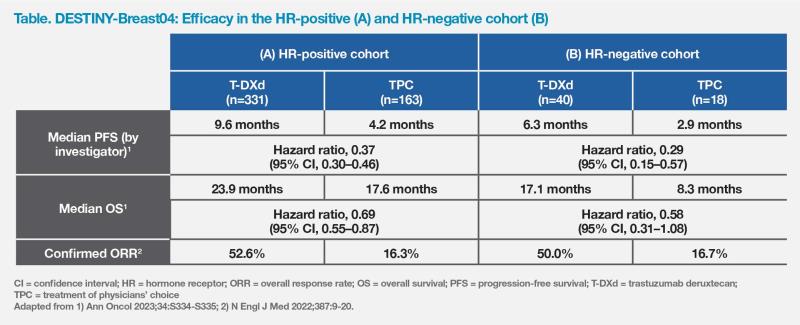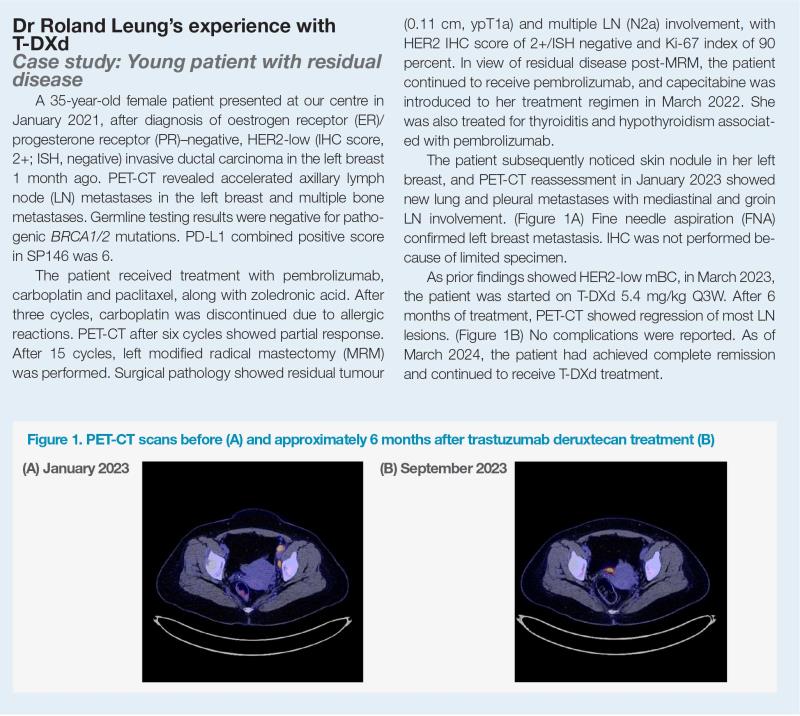Survival benefits of trastuzumab deruxtecan in patients with previously treated HER2-low mBC









The therapeutic landscape of HER2-low metastatic breast cancer (mBC) has been transformed by the availability of trastuzumab deruxtecan (T-DXd; Enhertu®, Daiichi Sankyo & AstraZeneca), an antibody-drug conjugate (ADC). At a recent Hong Kong Breast Cancer Foundation (HKBCF) Academic Meeting, Dr Shanu Modi of Memorial Sloan Kettering Cancer Center, Weill Cornell Medical College, New York, US, discussed the efficacy and safety of T-DXd in the phase III DESTINY-Breast04 trial. Local experiences with T-DXd were shared by Dr Roland Leung of the Department of Medicine, the University of Hong Kong.
Clinical landscape of HER2-low mBC
Low level of HER2 expression is defined as an immunohistochemistry (IHC) score of 1+, or 2+ with negative in situ hybridization (ISH). [Breast Cancer Res 2021;23:112] To date, most HER2-targeted therapies have demonstrated limited benefit for patients with HER2-low mBC. [Cancers 2022;14:3774; J Clin Oncol 2010;28:1131-1137; J Clin Oncol 2020;38:444-453] HER2-low mBC has thus been treated as HER2-negative disease stratified by hormone receptor (HR) status, with limited treatment options following tumour progression. [N Engl J Med 2022;387:9-20]
T-DXd, an ADC with a drug-to-antibody ratio of 8:1, comprises a HER2-directed antibody (trastuzumab) linked via a tetrapeptide-based cleavable linker to a topoisomerase I inhibitor payload. Upon internalization, T-DXd is selectively cleaved by lysosomal protease, leading to intracellular release of membrane-permeable exatecan derivative (DXd), which triggers tumour cell death. Subsequently, DXd diffuses and exerts its cytotoxic effect on nearby cancer cells via the bystander effect. [Curr Oncol 2023;30:6447-6461; Chem Pharm Bull (Tokyo) 2019;67:173-185]
“When released from T-DXd, DXd retains membrane permeability and enters the tumour microenvironment, targeting neighbouring tumour cells with heterogeneous levels of HER2 expression, including HER2-low tumour cells,” noted Modi.
T-DXd’s durable efficacy in HER2-low mBC
Phase Ib and II studies of T-DXd showed promising antitumour activity in pretreated patients with HER2-low mBC, with confirmed objective response rates (ORRs) of 37–37.5 percent. Median progression-free survival (PFS) was 6.8–11.1 months, and median overall survival (OS) was 19.3–29.4 months. [J Clin Oncol 2020;38:1887-1896; ESMO Open 2024;9:103016]
The phase III DESTINY-Breast04 trial investigated the efficacy and safety of T-DXd 5.4 mg/kg Q3W vs treatment of physician’s choice (TPC) in 557 patients with HER2-low mBC who had received 1–2 lines of chemotherapy, including those with HR-positive (n=494) and HR-negative (n=63) disease. At a median follow-up of 18.4 months, confirmed ORR in the T-DXd group was three times higher than the TPC group across the HR-positive cohort (52.6 vs 16.3 percent) and HR-negative cohort (50.0 vs 16.7 percent). (Table) [N Engl J Med 2022;387:9-20]

For patients in the HR-positive cohort, T-DXd demonstrated an approximately two-fold increase in median PFS vs TPC (10.1 vs 5.4 months; hazard ratio, 0.51; 95 percent confidence interval [CI] 0.40–0.64; p<0.001). Median OS was also significantly prolonged with T-DXd vs TPC (23.9 vs 17.5 months; hazard ratio, 0.64; 95 percent CI 0.48–0.86; p=0.003). T-DXd also showed similar survival improvements vs TPC in exploratory analyses of the HR-negative cohort (median PFS: 8.5 vs 2.9 months; hazard ratio, 0.46; 95 percent CI, 0.24–0.89) (median OS: 18.2 vs 8.3 months; hazard ratio, 0.48; 95 percent CI, 0.24–0.95).
Updated findings of DESTINY-Breast04 further demonstrated T-DXd’s durable efficacy. At a median follow-up of 32.0 months, survival improvements with T-DXd vs TPC were sustained in the HR-positive cohort (median PFS: 9.6 vs 4.2 months; hazard ratio, 0.37; 95 percent CI, 0.30–0.46) (median OS: 23.9 vs 17.6 months; hazard ratio, 0.69; 95 percent CI, 0.55–0.87). In exploratory analyses of the HR-negative cohort, median PFS was 6.3 vs 2.9 months with T-DXd vs TPC (hazard ratio, 0.29; 95 percent CI, 0.15–0.57), and median OS was 17.1 vs 8.3 months (hazard ratio, 0.58; 95 percent CI, 0.31–1.08). (Table) [Ann Oncol 2023;34:S334-S335]
Safety assessment in DESTINY-Breast04 showed that prolonged exposure to T-DXd did not increase toxicity. For any-grade treatment-emergent adverse events (TEAEs), exposure-adjusted incidence rates were 1.2 vs 2.6 per patient-year for the T-DXd vs TPC group. In the T-DXd group, the rate of any-grade interstitial lung disease/pneumonitis, an AE of special interest, was 12.1 percent, with no new cases reported since primary analysis.
“Compared with TPC, T-DXd is associated with significant survival benefit for previously treated patients with HER2-low mBC,” commented Modi.
NCCN recommendations
Based on results of DESTINY-Breast04, the National Comprehensive Cancer Network (NCCN) recommends T-DXd as a Category 1 preferred second-line regimen for patients with HR-positive, HER2-low (IHC 1+ or 2+/ISH negative), recurrent unresectable (local or regional) or stage IV BC who are endocrine-refractory or in visceral crisis, and for patients with HR-negative, HER2-low disease with no germline BRCA1/2 mutation. In both scenarios, T-DXd may be used in a later line if not used in the second line. [NCCN Clinical Practice Guidelines in Oncology, Breast Cancer, version 3, 2025]
Summary
“HER2-low mBC represents a new therapeutically targetable population,” concluded Modi. “For patients with HER2-low mBC, T-DXd is the preferred treatment after one line of chemotherapy.”

Discussion
In the overall study cohort (n=557) of DESTINY-Breast04, T-DXd showed greater clinical benefit, defined as a composite of complete response, partial response, and >6 months of stable disease, than TPC (70.2 vs 33.7 percent). [N Engl J Med 2022;387:9-20] This practice-changing clinical trial established the pivotal role of T-DXd as a second- or later-line treatment option for patients with HER2-low mBC. [NCCN Clinical Practice Guidelines in Oncology, Breast Cancer, version 3, 2025]